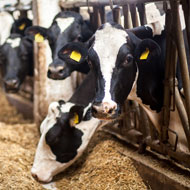Antimicrobial use ‘to rise by 52 per cent’

The latest UK sales data (2015) shows an average of 56mg/PCU, which is a 10 per cent reduction on the previous year.
New research suggests that antimicrobial use in animals destined for human consumption will rise by 52 per cent, reaching 200,000 tonnes, by 2030 - unless action is taken to limit their use.
Scientists from the ETH Zurich, Princeton, and the University of Cambridge carried out the first global assessment of intervention policies that could reduce this projected increase.
They describe the finding as ‘an alarming revision’ to already pessimistic estimates made in 2010. The figure has largely been pushed up by recent reports of high antimicrobial use in animals in China.
Published in the journal Science, the findings indicate that global antimicrobial consumption could be cut by 60 per cent, through capping usage at 50mg of antimicrobials per kilogram of animal per year in OECD countries. However, researchers acknowledge this may be difficult to enforce in resource-limited settings.
An alternative solution given is to impose a user fee of 50 per cent of the current price of veterinary antimicrobials, which is predicted to reduce global consumption by 31 per cent, generating $1.7-4.6 billion a year. Lead author Dr Thomas Van Boeckel said this revenue could be used to develop new antimicrobials or to improve farm hygiene, particularly in low and middle-income countries.
Commenting on the findings, RUMA chair Gwyn Jones said the global target of 50mg/PCU would be “unlikely to affect the UK” as it is among the lower users of antibiotics in farming around the world. Use of antibiotics for growth promotion has been banned in Europe for the past 10 years.
The latest UK sales data (2015) shows an average of 56mg/PCU, which is a 10 per cent reduction on the previous year. This places the UK government target of 50mg/PCU average sales across all sectors by 2018 “well within reach,” Mr Jones said.
While the suggestion “clearly has the potential to drive positive change in other countries”, he added, target figures alone are “blunt instruments” when it comes to reducing antimicrobial use.
“Wrongly managed, they have the potential to drive use of the highest priority critically-important antibiotics or cut treatment periods short. Equally, applying the same target to every species would not be supported by RUMA due to the diversity of agricultural sectors both in the UK and abroad…
“While it is important that vets and farmers take steps to reduce antibiotic use where they can, antibiotics remain an important tool for the preservation of animal health and welfare.”
RUMA also said it would be “concerned” about user fees and how these would be implemented.
Cambridge researchers acknowledge an important limiting factor in the research to be the difficulty in accessing data on veterinary antimicrobial sales volumes and prices. Their study is based on publicly available data, limited to 37 countries. Representatives from the animal health industry were reportedly approached but all refused to share information on sales and prices.
BVA’s president John Fishwick said: “This study highlights the pressing need to tackle antimicrobial resistance on a global scale and emphasises some of the challenges of achieving this goal, for example, in the difficulty of getting accurate data from many countries.
“The UK is in a much better position than many other countries, with sound evidence-based policies. We have accurate figures available on antimicrobial sales and are taking proactive steps to improve usage data.”
The UK’s veterinary profession has been working with the government and farming industry to develop sector-specific targets through the RUMA Targets Task Force, which will be revealed later this month. BVA is also feeding into the government’s new five-year antimicrobial resistance policy.



 The RCVS has announced a new version of its 1CPD mobile app, with enhanced features for veterinary surgeons and veterinary nurses to record their continuing professional development.
The RCVS has announced a new version of its 1CPD mobile app, with enhanced features for veterinary surgeons and veterinary nurses to record their continuing professional development.